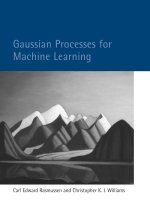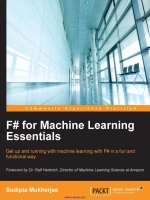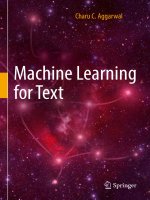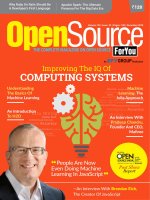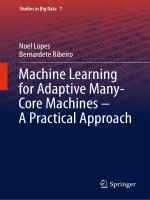F for machine learning
Bạn đang xem bản rút gọn của tài liệu. Xem và tải ngay bản đầy đủ của tài liệu tại đây (24.37 MB, 194 trang )
www.it-ebooks.info
F# for Machine Learning
Essentials
Get up and running with machine learning with F#
in a fun and functional way
Sudipta Mukherjee
BIRMINGHAM - MUMBAI
www.it-ebooks.info
F# for Machine Learning Essentials
Copyright © 2016 Packt Publishing
All rights reserved. No part of this book may be reproduced, stored in a retrieval
system, or transmitted in any form or by any means, without the prior written
permission of the publisher, except in the case of brief quotations embedded in
critical articles or reviews.
Every effort has been made in the preparation of this book to ensure the accuracy
of the information presented. However, the information contained in this book is
sold without warranty, either express or implied. Neither the author, nor Packt
Publishing, and its dealers and distributors will be held liable for any damages
caused or alleged to be caused directly or indirectly by this book.
Packt Publishing has endeavored to provide trademark information about all of the
companies and products mentioned in this book by the appropriate use of capitals.
However, Packt Publishing cannot guarantee the accuracy of this information.
First published: February 2016
Production reference: 1190216
Published by Packt Publishing Ltd.
Livery Place
35 Livery Street
Birmingham B3 2PB, UK.
ISBN 978-1-78398-934-8
www.packtpub.com
www.it-ebooks.info
Credits
Author
Project Coordinator
Sudipta Mukherjee
Bijal Patel
Reviewers
Proofreader
Alena Hall
Safis Editing
David Stephens
Indexer
Commissioning Editor
Rekha Nair
Ashwin Nair
Graphics
Abhinash Sahu
Acquisition Editors
Harsha Bharwani
Production Coordinator
Larissa Pinto
Aparna Bhagat
Content Development Editor
Athira Laji
Cover Work
Aparna Bhagat
Technical Editor
Ryan Kochery
Copy Editor
Alpha Singh
www.it-ebooks.info
www.it-ebooks.info
Foreword
Machine Learning (ML) is one of the most impactful technologies of the last 10 years,
fueled by the exponential growth of electronic data about people and their interaction
with the world and each other, as well as the availability of massive computing power
to extract patterns from data. Applications of ML are already affecting all of us in
everyday life, whether it's face recognition in modern cameras, personalized web or
product searches, or even the detection of road sign patterns in modern cars. Machine
learning is a set of algorithms that learn prediction programs from past data in order
to use them for future predictions—whether the prediction programs are represented
as decision trees, as neural networks, or via nearest-neighbor functions.
Another influential development in computer science is the invention of F#. Less
than 10 years ago, functional programming was a more of an academic endeavor
than a style of programming and software development used in production systems.
The development of F# since 2005 changed this forever. With F#, programmers are
not only able to benefit from type inference and easy parallelization of workflows,
but they also get the runtime performance that they are used to from programming
in other .NET languages, such as C#. I personally witnessed this transformation
at Microsoft Research and saw how data-intensive applications could be written
much more safely in less than 100 lines of F# code compared to thousands of lines
of C# code.
A critically important ingredient of ML is data; it's the lifeblood of any ML algorithm.
Parsing, cleaning, and visualizing data is the basis of any successful ML application
and constitutes the majority of the time that practitioners spend in making machine
learning systems work. F# proves to be the perfect bridge between data processing
and analysis, with ML on one hand and the ability to invent new ML algorithms on
the other hand.
www.it-ebooks.info
In this book, Sudipta Mukherjee introduces the reader to the basics of machine
learning, ranging from supervised methods, such as classification learning and
regression, to unsupervised methods, such as K-means clustering. Sudipta focuses
on the applied aspects of machine learning and develops all algorithms in F#, both
natively as well as by integrating with .NET libraries such as WekaSharp, Accord.Net
and Math.Net. He covers a wide range of algorithms for classification and regression
learning and also explores more novel ML concepts, such as anomaly detection. The
book is enriched with directly applicable source code examples, and the reader will
enjoy learning about modern machine learning algorithms through the numerous
examples provided.
Dr. Ralf Herbrich
Director of Machine Learning Science at Amazon
www.it-ebooks.info
About the Author
Sudipta Mukherjee was born in Kolkata and migrated to Bangalore. He is an
electronics engineer by education and a computer engineer/scientist by profession
and passion. He graduated in 2004 with a degree in electronics and communication
engineering.
He has a keen interest in data structure, algorithms, text processing, natural language
processing tools development, programming languages, and machine learning at
large. His first book on Data Structure using C has been received quite well. Parts
of the book can be read on Google Books at The book was
also translated into simplified Chinese, available from Amazon.cn at http://goo.
gl/lc536. This is Sudipta's second book with Packt Publishing. His first book,
.NET 4.0 Generics ( was also received very well. During
the last few years, he has been hooked to the functional programming style. His
book on functional programming, Thinking in LINQ ( was
released last year. Last year, he also gave a talk at @FuConf based on his LINQ book
( He lives in Bangalore with his wife and son.
Sudipta can be reached via e-mail at and via Twitter at
@samthecoder.
www.it-ebooks.info
Acknowledgments
First, I want to thank Dr. Don Syme (@dsyme) and everyone in the product
team who brought F# to the world and made a fantastic integration with Visual
Studio. I also want to thank Professor Andrew Ng (@AndrewYNg). I first learned
about machine learning from his MOOC on machine learning at Coursera
( />This book couldn't have seen the light of day without a few people: my acquisition
editor, Ms. Harsha Bharwani, who persuaded me to work on this book; and
my development editor, Ms. Athira Laji, who tolerated many delays in the
delivery schedule but kept the bar high and got me going. She is one of the most
compassionate development editors I have ever worked with. Thank you mam!
I have been fortunate to have a couple of very educated reviewers on board: Mr.
David Stephens (the PM of the F# programming language) (@NumberByColors) and
Ms. Alena Dzenisenka (@lenadroid). The book uses several open source frameworks
and F#. So, thanks to all the people who have contributed to these projects. I also
want to say a huge thank you to Dr. Ralf Herbrich (@rherbrich), the director of
machine learning science at Amazon, Berlin, for kindly writing a foreword for
the book.
Last but not least, I must say that I am very fortunate to have a very loving family,
who always stood by me whenever I needed support. My wife, Mou, made sure that
I had enough time to write the chapters. We couldn't go out on weekends. I promise
to make up for all the missed family time. Thank you sweetheart! My son, Sohan,
has been my inspiration. His enthusiasm makes me feel happy. Love you son. I
hope when he grows up, machine learning will be more mainstream and will have
become far more commonplace in the programming ecosystem than it is now. My
dad, Subrata, always inspired me to learn more about mathematics. I realized how
important mathematics is in programming while writing this book. My mom, Dipali,
taught me mathematics in my early years and what I know today about mathematics
is deeply rooted in her teachings. I love you all!
I am thankful to God for giving me the strength to dream big and fight my nightmares.
www.it-ebooks.info
About the Reviewers
Alena Hall is an experienced Solution Architect proficient in distributed cloud
programming, real-time system modeling, higher load and performance, big data
analysis, data science, functional programming, and machine learning. She is a
speaker at international conferences and a member of the F# Board of Trustees.
David Stephens is the program manager for Visual F# at Microsoft. He's
responsible for representing the needs of F# developers within Microsoft, managing
the development of new features, and evangelizing F#. Prior to joining the .NET
team, David worked on tools for Apache Cordova, the F12 developer tools in
Microsoft Edge, TypeScript, and .NET Native. He has a bachelor's degree in
computer science and mathematics from the Raikes School of Computer Science
and Management at the University of Nebraska in Lincoln, Nebraska, USA.
www.it-ebooks.info
www.PacktPub.com
eBooks, discount offers, and more
Did you know that Packt offers eBook versions of every book published, with PDF
and ePub files available? You can upgrade to the eBook version at www.PacktPub.com
and as a print book customer, you are entitled to a discount on the eBook copy. Get in
touch with us at for more details.
At www.PacktPub.com, you can also read a collection of free technical articles, sign
up for a range of free newsletters and receive exclusive discounts and offers on Packt
books and eBooks.
TM
/>
Do you need instant solutions to your IT questions? PacktLib is Packt's online digital
book library. Here, you can search, access, and read Packt's entire library of books.
Why subscribe?
• Fully searchable across every book published by Packt
• Copy and paste, print, and bookmark content
• On demand and accessible via a web browser
www.it-ebooks.info
Table of Contents
Prefacev
Chapter 1: Introduction to Machine Learning
1
Objective1
Getting in touch
2
Different areas where machine learning is being used
2
Why use F#?
3
Supervised machine learning
5
Training and test dataset/corpus
Some motivating real life examples of supervised learning
Nearest Neighbour algorithm (a.k.a k-NN algorithm)
Distance metrics
Decision tree algorithms
5
6
7
7
8
Unsupervised learning
13
Machine learning frameworks
15
Machine learning for fun and profit
15
Recognizing handwritten digits – your "Hello World" ML program
16
How does this work?
20
Summary22
Chapter 2: Linear Regression
23
Objective23
Different types of linear regression algorithms
23
APIs used
24
Math.NET Numerics for F# 3.7.0
24
Getting Math.NET
25
Experimenting with Math.NET
25
The basics of matrices and vectors (a short and sweet refresher)
25
Creating a vector
26
Creating a matrix
26
[i]
www.it-ebooks.info
Table of Contents
Finding the transpose of a matrix
28
Finding the inverse of a matrix
28
Trace of a matrix
29
QR decomposition of a matrix
29
SVD of a matrix
30
Linear regression method of least square
32
Finding linear regression coefficients using F#
33
Finding the linear regression coefficients using Math.NET
40
Putting it together with Math.NET and FsPlot
40
Multiple linear regression
42
Multiple linear regression and variations using Math.NET
44
Weighted linear regression
45
Plotting the result of multiple linear regression
47
Ridge regression
49
Multivariate multiple linear regression
50
Feature scaling
52
Summary53
Chapter 3: Classification Techniques
55
Objective55
Different classification algorithms you will learn
56
Some interesting things you can do
56
Binary classification using k-NN
56
How does it work?
Finding cancerous cells using k-NN: a case study
Understanding logistic regression
The sigmoid function chart
Binary classification using logistic regression (using Accord.NET)
Multiclass classification using logistic regression
How does it work?
Multiclass classification using decision trees
Obtaining and using WekaSharp
How does it work?
Predicting a traffic jam using a decision tree: a case study
Challenge yourself!
Summary
Chapter 4: Information Retrieval
60
60
63
64
67
69
73
73
74
76
77
80
80
81
Objective81
Different IR algorithms you will learn
81
What interesting things can you do?
82
[ ii ]
www.it-ebooks.info
Table of Contents
Information retrieval using tf-idf
Measures of similarity
Generating a PDF from a histogram
Minkowski family
L1 family
Intersection family
Inner Product family
Fidelity family or squared-chord family
Squared L2 family
Shannon's Entropy family
Similarity of asymmetric binary attributes
Some example usages of distance metrics
Finding similar cookies using asymmetric binary similarity measures
82
84
84
86
87
89
92
94
96
99
103
108
108
Grouping/clustering color images based on Canberra distance
110
Summary111
Chapter 5: Collaborative Filtering
113
Chapter 6: Sentiment Analysis
137
Objective113
Different classification algorithms you will learn
113
Vocabulary of collaborative filtering
114
Baseline predictors
114
Basis of User-User collaborative filtering
116
Implementing basic user-user collaborative filtering using F#
119
Code walkthrough
121
Variations of gap calculations and similarity measures
123
Item-item collaborative filtering
125
Top-N recommendations
128
Evaluating recommendations
128
Prediction accuracy
129
Confusion matrix (decision support)
130
Ranking accuracy metrics
134
Prediction-rating correlation
134
Working with real movie review data (Movie Lens)
135
Summary136
Objective137
What you will learn
138
A baseline algorithm for SA using SentiWordNet lexicons
138
Handling negations
141
Identifying praise or criticism with sentiment orientation
145
Pointwise Mutual Information
146
Using SO-PMI to find sentiment analysis
147
Summary149
[ iii ]
www.it-ebooks.info
Table of Contents
Chapter 7: Anomaly Detection
151
Objective151
Different classification algorithms
151
Some cool things you will do
152
The different types of anomalies
152
Detecting point anomalies using IQR (Interquartile Range)
154
Detecting point anomalies using Grubb's test
155
Grubb's test for multivariate data using Mahalanobis distance
157
Code walkthrough
159
Chi-squared statistic to determine anomalies
159
Detecting anomalies using density estimation
160
Strategy to convert a collective anomaly to a point
anomaly problem
162
Dealing with categorical data in collective anomalies
163
Summary164
Index165
[ iv ]
www.it-ebooks.info
Preface
Machine learning (ML) is more prevalent now than ever before. Every day a lot of
data is being generated. Machine learning algorithms perform heavy duty number
crunching to improve our lives every day. The following image captures the major
tasks that machine learning algorithms perform. These are the classes or types of
problems that ML algorithms solve.
Our lives are more and more driven by the output of these ML algorithms than we
care to admit. Let me walk you through the image once:
• Computers everywhere: Now your smartphone can beat a vintage
supercomputer, and computer are everywhere: in your phone,
camera, car, microwave, and so on.
• Clustering: Clustering is the task of identifying groups of items from a given
list that seem to be similar to the others in the group. Clustering has many
diverse uses. However, it is heavily used in market segment analysis to
identify different categories of customers.
[v]
www.it-ebooks.info
Preface
• Classification: This is the ML algorithm that works hard to keep your spam
e-mails away from your priority inbox. The same algorithm can be used to
identify objects from images or videos and surprisingly, the same algorithm
can be used to predict whether a patient has cancer or not. Generally, a lot of
data is provided to the algorithm, from which it learns. That's why this set
of algorithms is sometime referred to as supervised learning algorithms,
and this constitutes the vast majority of machine learning algorithms.
• Predictions: There are several ML algorithms that perform predictions for
several situations that are important in life. For example, there are predictors
that predict fuel price in the near future. This family of algorithms is known
as regressions.
• Anomaly detection: Anomaly, as the name suggests, relates to items that
have attributes that are not similar to normal ones. Anomaly detection
algorithms use statistical methods to find out the anomalous items from
a given list automatically. This is an example of unsupervised learning.
Anomaly detection has several diverse uses, such as finding faulty items in
factories to finding intruders on a video stream coming from a surveillance
camera, and so on.
• Recommendations: Every time you visit Amazon and rate a product, the site
recommends some items to you. Under the hood is a clever machine learning
algorithm in action called collaborative filtering, which takes cues from other
users purchasing similar items as you are. Recommender systems are a very
active research topic now and several other algorithms are being considered.
• Sentiment analysis: Whenever a product hits the market, the company that
brought it into the market wants to know how the market is reacting towards
it. Is it positive or negative? Sentiment analysis techniques help to identify
these reactions. Also, in review websites, people post several comments,
and the website might be interested in publishing a generalized positive
or negative rating for the item under review. Here, sentiment analysis
techniques can be quite helpful.
• Information retrieval: Whenever you hit the search button on your favorite
search engine, a plethora of information retrieval algorithms are used under
the hood. These algorithms are also used in the content-based filtering that is
used in recommender systems.
[ vi ]
www.it-ebooks.info
Preface
Now that you have a top-level idea of what ML algorithms can do for you, let's see
why F# is the perfect fit for the implementations. Here are my reasons for using F#
to implement machine learning algorithms:
What this book covers
Chapter 1, Introduction to Machine Learning, introduces machine learning concepts.
Chapter 2, Linear Regression, introduces and implements several linear regression
models using F#.
Chapter 3, Classification Techniques, introduces classification as a formal problem and
then solves some use cases using F#.
Chapter 4, Information Retrieval, provides implementations of several information
retrieval distance metrics that can be useful in several situations.
Chapter 5, Collaborative Filtering, explains the workhorse algorithm for recommender
systems, provides an implementation using F#, and then shows how to evaluate
such a system.
Chapter 6, Sentiment Analysis, explains sentiment analysis and after positioning it as a
formal problem statement, solves it using several state-of-the-art algorithms.
Chapter 7, Anomaly Detection, explains and poses the anomaly detection problem
statement and then gives several algorithms and their implementation in F#.
[ vii ]
www.it-ebooks.info
Preface
What you need for this book
You will need Visual Studio 2010 or above and a good internet connection because
some of the plotting APIs used here rely on connectivity.
Who this book is for
If you are a C# or F# developer who now wants to explore the area of machine
learning, then this book is for you. No prior knowledge of machine learning
is assumed.
Conventions
In this book, you will find a number of styles of text that distinguish between
different kinds of information. Here are some examples of these styles, and an
explanation of their meaning.
Code words in text, database table names, folder names, filenames, file extensions,
pathnames, dummy URLs, user input, and Twitter handles are shown as follows:
"For example, able has a positive polarity of 0.125 and unable has a negative
polarity of 0.75."
A block of code is set as follows:
let calculateSO (docs:string list list)(words:string list)=
let mutable res = 0.0
for i in 0 .. docs.Length - 1 do
for j in 0 .. docs.[i].Length - 1
do
for pw in words do
res <- res + pmi docs docs.[i].[j] pw
res
When we wish to draw your attention to a particular part of a code block, the
relevant lines or items are set in bold:
Calling this function is simple as shown below.
//The above rating matrix is represented as (float list)list in F#
let ratings = [[4.;0.;5.;5.];[4.;2.;1.;0.];[3.;0.;2.;4.];[4.;4.;0.;0.]
;[2.;1.;3.;5.]]
//Finding the predicted rating for user 1 for item 2
let p12 = Predictu ratings 0 1
[ viii ]
www.it-ebooks.info
Preface
Any command-line input or output is written as follows:
if d1 = 0.0 || d2 = 0.0 then 0.0 else num
/ ((sqrt d1) * (sqrt d2 ))
New terms and important words are shown in bold. Words that you see on
the screen, in menus or dialog boxes for example, appear in the text like this:
"Navigate to user id and then on item id."
Warnings or important notes appear in a box like this.
Tips and tricks appear like this.
Reader feedback
Feedback from our readers is always welcome. Let us know what you think about
this book—what you liked or may have disliked. Reader feedback is important for
us to develop titles that you really get the most out of.
To send us general feedback, simply send an e-mail to ,
and mention the book title via the subject of your message.
If there is a topic that you have expertise in and you are interested in either writing
or contributing to a book, see our author guide on www.packtpub.com/authors.
Customer support
Now that you are the proud owner of a Packt book, we have a number of things
to help you to get the most from your purchase.
Downloading the example code
You can download the example code files from />fsharpforml. You can also visit www.twitter.com/fsharpforml for more updates
on the F#.
[ ix ]
www.it-ebooks.info
Preface
Downloading the color images of this book
We also provide you with a PDF file that has color images of the screenshots/
diagrams used in this book. The color images will help you better understand the
changes in the output. You can download this file from ktpub.
com/sites/default/files/downloads/FForMachineLearning_ColorImages.pdf.
Errata
Although we have taken every care to ensure the accuracy of our content, mistakes
do happen. If you find a mistake in one of our books—maybe a mistake in the text or
the code—we would be grateful if you could report this to us. By doing so, you can
save other readers from frustration and help us improve subsequent versions of this
book. If you find any errata, please report them by visiting ktpub.
com/submit-errata, selecting your book, clicking on the Errata Submission Form
link, and entering the details of your errata. Once your errata are verified, your
submission will be accepted and the errata will be uploaded to our website or added
to any list of existing errata under the Errata section of that title.
To view the previously submitted errata, go to />content/support and enter the name of the book in the search field. The required
information will appear under the Errata section.
Piracy
Piracy of copyrighted material on the Internet is an ongoing problem across all
media. At Packt, we take the protection of our copyright and licenses very seriously.
If you come across any illegal copies of our works in any form on the Internet, please
provide us with the location address or website name immediately so that we can
pursue a remedy.
Please contact us at with a link to the suspected
pirated material.
We appreciate your help in protecting our authors and our ability to bring you
valuable content.
Questions
If you have a problem with any aspect of this book, you can contact us at
, and we will do our best to address the problem.
[x]
www.it-ebooks.info
Introduction to Machine
Learning
"To learn is to discover patterns."
You have been using products that employ machine learning, but maybe you've
never realized that the systems or programs that you have been using, use machine
learning under the hood. Most of what machine learning does today is inspired by
sci-fi movies. Machine learning scientists and researchers are on a perpetual quest
to make the gap between the sci-fi movies and the reality disappear. Learning about
machine learning algorithms can be fun.
This is going to be a very practical book about machine learning. Throughout the
book I will be using several machine learning frameworks adopted by the industry.
So I will cut the theory of machine learning short and will get away with just enough
to implement it. My objective in this chapter is to get you excited about machine
learning by showing how you can use these techniques to solve real world problems.
Objective
After reading this chapter, you will be able to understand the different terminologies
used in machine learning and the process of performing machine learning activities.
Also, you will be able to look at a problem statement and immediately identify which
problem domain the problem belongs to; whether it is a classification or a regression
problem, and such. You will find connections between seemingly disparate sets of
problems. You will also find basic intuition behind some of the major algorithms
used in machine learning today. Finally, I wrap up this chapter with a motivating
example of identifying hand written digits using a supervised learning algorithm.
This is analogous to your Hello world program.
[1]
www.it-ebooks.info
Introduction to Machine Learning
Getting in touch
I have created the following Twitter account for you (my dear reader) to get in touch
with me. If you want to ask a question, post errata, or just have a suggestion, tag this
twitter ID and I will surely get back as soon as I can.
/>
I will post contents here that will augment the content in the book.
Different areas where machine learning is
being used
The preceding image shows some of the areas where machine learning techniques
are used extensively. In this book, you will learn about most of these usages.
Machines learn almost the same way as we humans do. We learn in three different
ways.
As kids our parents taught us the alphabets and thus we can distinguish between the
A's and H's. The same is true with machines. Machines are also taught the same way
to recognize characters. This is known as supervised learning.
While growing up, we taught ourselves the differences between the teddy bear toy
and an actual bear. This is known as unsupervised learning, because there is no
supervision required in the process of the learning. The main type of unsupervised
learning is called clustering; that's the art of finding groups in unlabeled datasets.
Clustering has several applications, one of them being customer base segmentation.
[2]
www.it-ebooks.info
Chapter 1
Remember those days when you first learnt how to take the stairs? You probably
fell many times before successfully taking the stairs. However, each time you fell,
you learnt something useful that helped you later. So your learning got re-enforced
every time you fell. This process is known as reinforcement learning. Ever saw
those funky robots crawling uneven terrains like humans. That's the result of
re-enforcement learning. This is a very active topic of research.
Whenever you shop online at Amazon or on other sites, the site recommends back
to you other stuff that you might be interested in. This is done by a set of algorithms
known as recommender systems.
Machine learning is very heavily used to determine whether suspicious credit
card transactions are fraudulent or not. The technique used is popularly known as
anomaly detection. Anomaly detection works on the assumption that most of the
entries are proper and that the entry that is far (also called an outlier) from the other
entries is probably fraudulent.
In the coming decade, machine learning is going to be very commonplace and it's
about time to democratize the machine learning techniques. In the next few sections,
I will give you a few examples where these different types of machine learning
algorithms are used to solve several problems.
Why use F#?
F# is an open source, functional-first, general purpose programming language and is
particularly suitable for developing mathematical models that are an integral part of
machine learning algorithm development.
[3]
www.it-ebooks.info
Introduction to Machine Learning
Code written in F# is generally very expressive and is close to its actual algorithm
description. That's why you shall see more and more mathematically inclined
domains adopting F#.
At every stage of a machine learning activity, F# has a feature or an API to help.
Following are the major steps in a machine learning activity:
Major step in
machine learning
activity
How F# can help
Data Acquisition
F# type providers are great at it. (Refer to http://blogs.
msdn.com/b/dsyme/archive/2013/01/30/twelve-typeproviders-in-pictures.aspx)
F# can help you get the data from the following resources using F#
type providers:
• Databases (SQL Server and such)
• XML
• CSV
• JSON
• World Bank
• Cloud Storages
• Hive
Data Scrubbing/
Data Cleansing
F# list comprehensions are perfect for this task.
Learning the
Model
WekaSharp is an F# wrapper on top of Weka to help with machine
learning tasks such as regression, clustering, and so on.
Deedle ( />Deedle/) is an API written in F#, primarily for exploratory data
analysis. This framework also has lot of features that can help in the
data cleansing phase.
Accord.NET is a massive framework for performing a very diverse
set of machine learning.
Data Visualization
F# charts are very interactive and intuitive to easily generate high
quality charts. Also, there are several APIs, such as FsPlot, that take
the pain of conforming to standards when it comes to plugging data
to visualization.
F# has a way to name a variable the way you want if you wrap it with double back
quotes like—"my variable". This feature can make the code much more readable.
[4]
www.it-ebooks.info


